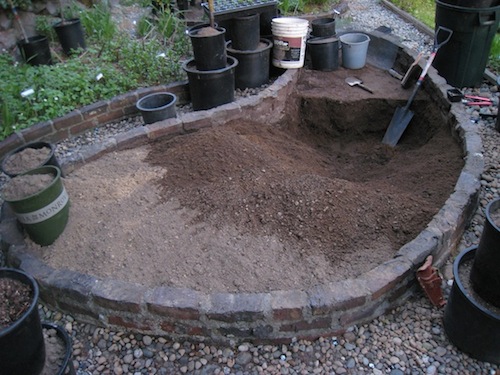Plant of the Month: April 2012
|
Vegetables in Seattle
|
| This is an essay on vegetables. My 2012 New Year's Resolution was: grow more of my own food in Seattle. That translates to more vegetables, mainly. As a child, I favored sweets and fruits; as an adult, I prefer vegetables and appreciate bitter and spicy flavors more than sweets. |
| Life on planet Earth is grouped into the Animal Kingdom, Fungal Kingdom and Plant Kingdom --the latter also called Vegetable Kingdom. In the broad sense, vegetable matter is anything containing chlorophyl. In the culinary sense, vegetables are a category of edible plants akin to but different from fruits. Botanists use the term "fruit" to refer to ripened or mature ovaries, but do not use in a restricted scientific sense the term "vegetable." |
| Most Seattle residents are accustomed to a selection of common produce-stand vegetable crops. For example: asparagus, cabbage, carrot, celery, lettuce, and radish. These are old European vegetables. New World species include corn (maize), potato, sunflower, most squashes, some beans. Tropical or subtropical species include bell pepper, sweet potato, eggplant, peanut, Malabar spinach, and okra. Wild vegetables include lambsquarters, stinging nettles, seaweeds, and fern fiddleheads. A category of ephemeral vegetables that are seldom known and less often consumed, include young tender spring leaves of certain "ornamental" shrubs and trees such as: Bamboo, Beech, Deodar Cedar, Hibiscus, Linden, Mulberry, Coast Redwood, Sorrel Tree, Weeping Willow, and Yellowhorn. Finally, edible houseplant vegetables that are tropical or subtropical include: Begonia, Chaya, Ficus, Peperomia, Taro, etc. |
| The stereotypical farm is a flat piece of plentiful land in full sun, such as an Iowa cornfield. In contrast, most big-city residents face little space, more pollution, some shade, tree root competition, and usually compacted soil of less fertility. Urban food gardening, at least in Seattle, has some benefits, too: warmer than in nearby rural river valleys; ready access to tools, help, markets, and supplies; and for most neighborhoods, no flooding worries. Necessity breeds ingenuity. For example, a tenant of good farming is crop rotation. In tight urban places, this is impractical. But city gardeners use containers, and rotate those; we use walls and roofts; we grow crops suited to our microclimate, and trade harvests with friends for some of their surplus. |
| The keys to maximum yields of garden vegetables: organic, living soil; ample nitrogen; ideal moisture; ideal light level; ideal temperature; loosened soil. Using season extending techniques, and pest-control practices, along with shrewd use of containers, also helps. For example, take tomato. It needs warmth. So, broadcasting seeds in your garden bed is not as efficient as starting the seeds inside, then planting the seedlings in containers and placing the containers in the warmest spot you have, at that time in June when the temperature is 65 degrees or higher. |
| Many decisions must be made. The choice of what to grow in an urban home garden, is partly a matter of taste, but also logically of what your site will permit. Raise your own plants from seed, or buy seedlings? Open-pollinated varieties or hybrids? Manure or non-manure fertilizer? Homemade composting, or purchased? Organic practices or not? Year-round, or only summer gardening? Do it all yourself, or get help? |
| This spring, I started a garden renovation wherein 3 of my brick-bordered raised beds of mixed plantings, are to be converted wholly to vegetable production. The first complete bed is show in the photos. Before the transformation, it grew 42 different kinds of plants, from annuals to shrubs. I dug and loosened the soil to a depth of 2 feet, removing rocks and tree roots from 9 kinds of my trees: fir, plum, eucalyptus, pine, mulberry, dogwood, pawpaw, fig and cedar --the latter tree over 30 feet away. Then I added compost, lime, fertilizer, and planted 9 kinds of vegetable seedlings that I had raised in flats: Chard, Mustard, Parsnip, Plantago Coronopus, Radish (2 kinds), Rutabaga, Black Salsify, and Turnip. |
| I shall place a floating row cover to ward off cabbage maggots, and will water when the rain fails. I tried to adopt principles advocated in the book by John Jeavons titled How to Grow More Vegetables. On the whole, I like and commend this book and its GROW BIOINTENSIVETM advice. Note that its biases include the author's rural, California, location --a far cry from big city Seattle. Its charts of vegetables are largely conventional and familiar, while I plan to also grow rarities such as the Plantago Coronopus cited above. |
| Crops that are not notably heat-needing, will go in the brick-bordered raised beds. Heat-needing crops will be grown in containers --including hanging baskets and earthboxesTM-- that can be placed in warm spots. Potatoes are grown mostly in containers, too, for ease of harvesting. Most perennial vegetables are planted in other beds where they can be left alone. |
| I purchased a heat mat, grow lights, and flats to start seedlings indoors. The cost of these accoutrements, plus fertilizer, potting soil, seeds, and the like, is considerable. Days of labor are also needed. There is no question that this year it would be less costly to buy vegetables than to grow them the way that I am. However, to grow my own, confers a degree of control, health, interaction, and satisfaction that I treasure. Also, I plan to allow some of each crop to set seed, so no need to buy seeds each year hereafter. |
The Old Farmer's Almanacpredicts that the weather in my region will be cool this spring, then extra warm in summer. That is welcome news. Other seeds that I have to sow include: Amaranth, Bean, Beet, Onion, Pepper, Purslane, Squash, and Tomato.
Back |

double digging the vegetable bed ; photo by ALJ
|

the planted vegetable bed ; photo by ALJ
|
|
|

